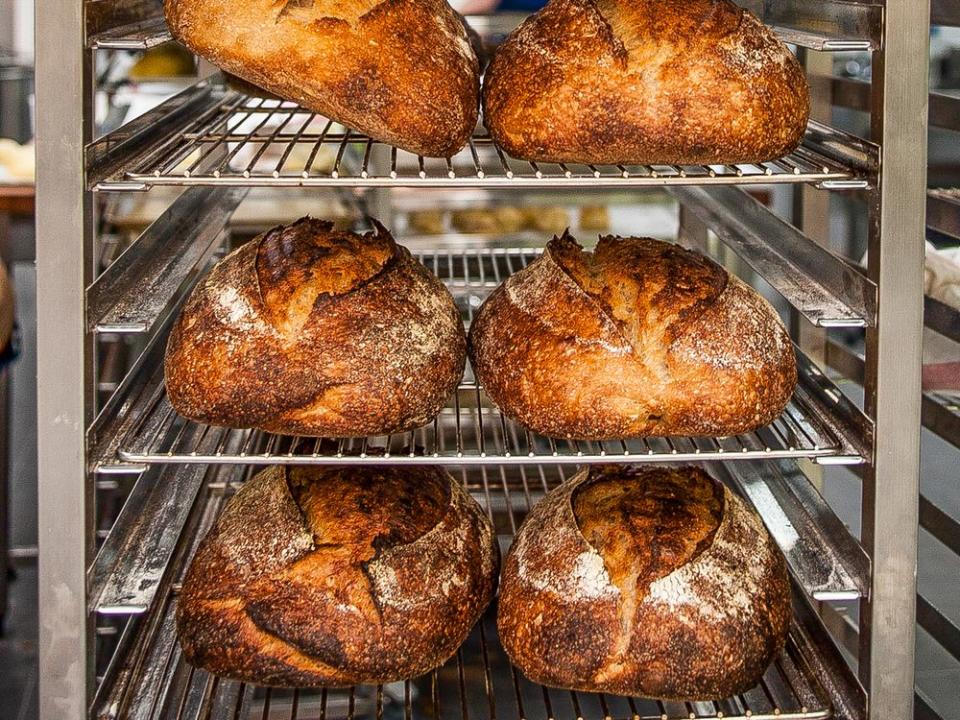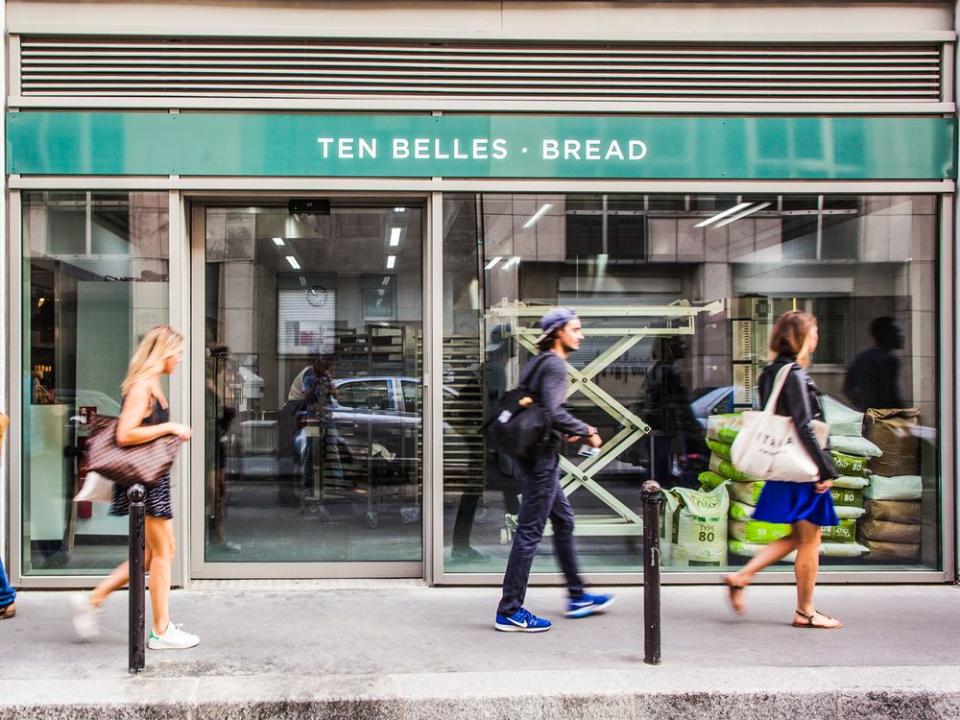A New Sourdough Culture Rises in Paris
This past June, there was an absolutely brutal heatwave in France. Temperatures rocketed to almost 110 degrees in Paris, and no matter where you were, it was sweltering and uncomfortable, made worse by France’s ambivalent relationship with air conditioning. The whole country was dripping in sweat, but nowhere more so than in France’s bakeries, where hot ovens could reach into the several hundreds of degrees even on a cold day. At Ten Belles Bread, a popular bakery in Paris’ 11th arrondissement, the heatwave meant checking on dough and turning on ovens sometimes as early as 1:30 a.m.
Bakers have always worked at ungodly hours, but in the summer their schedule was due less to the idiosyncrasies of bakers than to the kind of bread Ten Belles makes: a 100% sourdough with wild yeast that’s as susceptible to changes in environment as humans in a heatwave.
Sourdough—or as it’s called with various degrees of veracity in France, pain au levain—acts according to the environment it’s in. When the temperature is hot and humid, the natural yeast ferments faster. When it’s cold and dry, it is slow to develop and stubborn to rise. It can be extremely challenging to work with sourdough, which is one reason why pain au levain, despite being a staple of the French diet throughout history, had all but disappeared in France until recently. With the arrival of more reliable commercial bakers’ yeast in the early 1900s, unpredictable levain, which required near-constant monitoring, was simply too much work.

In recent years, though, the sourdough landscape in France has suddenly and rapidly changed. Alongside the rekindled interest in sourdough bread in America, bakeries like Ten Belles have popped up all over Paris and France at large, serving bread made only with 100% levain—unpredictability be damned. There are now an enormous range of bakeries selling true 100% sourdough bread in Paris: Le Bricheton, Mamiche, Levain Le Vin, Panifica, Terroirs d’Avenir, Archibald, Fermentation Generale, and Circus Bakery, to name a few in the city alone.
“It wasn't until we opened and I saw people's reactions that I realized that we were actually doing something that was really going against the grain and not what people expected,” Alice Quillet, baker and co-owner of Ten Belles, told me at the bakery one morning in November. “It wasn't the usual framework of a bakery and people didn’t understand what you could eat here. People were pissed off because it had an English name. We also didn't make baguettes. We didn't make any French viennoiseries. We didn't do anything the way you're supposed to do it. And also, we were staffed by women.”
Cultivating and caring for a starter, as anyone who has ever dabbled in sourdough knows, is not easy. It’s like having a child. Before the invention of commercial yeast in the early 1900s, professional bakers in France were refreshing their levain starters up to four times in one day, Dr. Steven L. Kaplan, a historian on French bread and author of Good Bread Is Back, told me. “You have to feed the beast,” he said. “It used to be, if you did a levain, particularly a levain dur (or hard levain), that was a sign of your baking virtuosity. It was a sign that you were a prince de la pâte, a prince of the dough. Now, we have a lot of people who are doing bread with liquid levain that is dispensed by a machine, so there's none of this relationship that you [would] have with your mother starter.”
When baguettes were popularized in France in the mid-1920s, pain au levain was abandoned in cities almost entirely. “The baguette was invented because middle and upper class people in the cities wanted to eat fresh bread several times a day. They thought that the big loaves, which you'd eat for two or three days, were old-fashioned and corny, that they didn't belong to their epoch,” Kaplan added. During the war, when the availability of commercial yeast was limited, French authorities released leaflets pleading with bakers to return to sourdough, in order to keep bread production up. But by then, so few bakers knew how to properly make pain au levain that, by the end of the war, demand was even higher for bread made with commercial yeast. “All the experts declared that levain was too long, too complicated, too hard, and it had a lousy taste anyway,” Kaplan recounted. “Bread just got worse and worse and worse.”

The only thing that Ten Belles does now that is spiritually similar to every other boulangerie in Paris—make and sell bread—ended up being the most confusing for Parisians. That’s because pain au levain, though readily available in name in most boulangeries across France, is often not what it seems. In a decree made by the French government in 1993, pain au levain was declared acceptable even if the mix contained commercial yeast to aid in the bread’s rise. Levains used in doughs could also be previously dehydrated. The flour could be a cheap readymade blend leeched of nutrition and enhanced with dough improvers and emulsifiers. As long as there was some semblance of active culture, it could be called pain au levain. This led to many bakeries cutting corners, taking advantage of the growing trend, and selling pain au levain that was a far cry from its healthful artisanal roots.
“When I realized you could buy sourdough off of a catalog, I realized that sourdough didn't mean anything anymore,” Apollonia Poilâne, author of the recently published Poilâne: The Secrets of the World-Famous Bread Bakery and CEO of Poilâne (arguably the most famous sourdough bakery in Paris), told me one morning over a breakfast of buttered toast. “I was in college, reading in my profession's magazines about sourdough this, sourdough that. I was seeing more and more sourdough bakeries claiming to be sourdough,” she said, dismayed. “It's such a motherfucker to work the way that we do. It's such a commitment to our craft.” When Poilâne talks about ordering sourdough from a catalog, she is referring to initiatives like the Puratos Sourdough catalog, where you can order three different kinds of sourdough, from varying countries and traditions. To Poilâne, that is a cheap substitute for otherwise hard work: “Sourdough bought off a catalog cannot be the same thing as something we've been nurturing.”
But it’s this return to pain au levain that is giving bread-lovers like Kaplan, Quillet, and Poilâne hope. Not only because it means a return to historical tradition, through a kind of bread that sustained generations of French people, but a renewed emphasis on ingredients, healthfulness, and taste. As journalist Marie Astier writes in Quel Pain Voulons-Nous? (or What Bread Do We Want?), the recent push for organic well-sourced ingredients is slowly but surely spilling over into bread. It wasn’t previously common to ask your boulanger what type of flour they use, but that is something that she believes is changing, too.
“The artisan baker in France is sacrosanct. You don't question where any of their bread comes from,” Ten Belles’ Quillet told me. “But I realized that, because people are trying to learn the provenance of their food, it took a while to trickle down to bread.” Quillet sees her customers identifying the other benefits of eating sourdough bread, as well. “People are realizing that fermentation is relevant to gut health and digestibility so it fits into that trend. People are also more conscious of waste. Sourdough, you can eat over a period of three days.” An average baguette, on the other hand, turns into biscotti in barely a few hours. Information isn’t hard to find, either: at Ten Belles and Levain Le Vin, bakers can be seen shaping dough through the bakeries’ front windows. For Levain Le Vin’s Christophe Fertillet, that has more or less eradicated any learning curve: “People are curious. When we work [right in front of the window], it’s almost necessary to explain what we’re doing.”
“If you have an appreciation for what's going on with your bread, you don't eat it in the same way,” Poilâne told me, wistful. “You take the time to chew it, eat it, taste it. That experience will contrast with people saying bread makes you fat, that bread makes you bloated. Of course it will—if you eat bad bread. The more we educate people, the more they can discriminate, and that leads to better choices about what kind of bread they’re willing to eat.”

